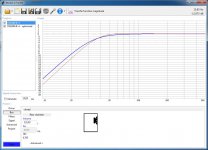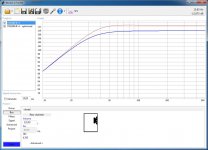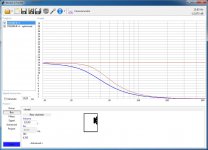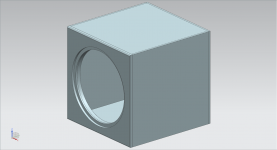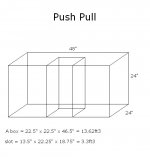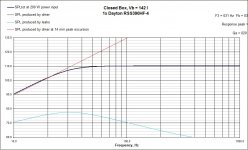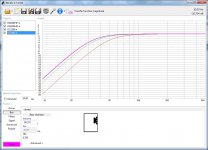Dayton Audio RSS390HF-4 15" (first) build - would like to get some feedback on WinISD
Currently, I am designing my first sealed subwoofer which I would like to use in my living room for both music and HT. I am still unsure if I will manufacture one or two; I am leaning more towards two eventually. I do like the symmetrical look.
After a lot of reading on this forum; I decided to use the following driver: Dayton Audio RSS390HF-4 15". I used WinISD to simulate the response and Siemens NX to design the enclosure.
I designed two enclosures:
1) 81,55 liter - 0,815 Qtc (red line and signal set to 375W)
2) 132,93 liter - 0,703 Qtc (blue line and signal set to 200W).
Dayton Audio recommends 81,55 liter for a sealed enclosure.
1) How does the graphs look to the more experienced WinISD users?
2) Many people tend to recommend internal volumes of 5 cubic feet ~ 142 liter; why is this better? The smaller enclosure has higher SPL on every frequency.
3) Is it allowed to exceed the cone excursion limit at lower frequencies (c.q. 10 to 15 Hz?).
Currently, I am designing my first sealed subwoofer which I would like to use in my living room for both music and HT. I am still unsure if I will manufacture one or two; I am leaning more towards two eventually. I do like the symmetrical look.
After a lot of reading on this forum; I decided to use the following driver: Dayton Audio RSS390HF-4 15". I used WinISD to simulate the response and Siemens NX to design the enclosure.
I designed two enclosures:
1) 81,55 liter - 0,815 Qtc (red line and signal set to 375W)
2) 132,93 liter - 0,703 Qtc (blue line and signal set to 200W).
Dayton Audio recommends 81,55 liter for a sealed enclosure.
1) How does the graphs look to the more experienced WinISD users?
2) Many people tend to recommend internal volumes of 5 cubic feet ~ 142 liter; why is this better? The smaller enclosure has higher SPL on every frequency.
3) Is it allowed to exceed the cone excursion limit at lower frequencies (c.q. 10 to 15 Hz?).
Attachments
Last edited:
I don't use winisd, but.....
Using the classic formulas, qtc .707 (lowest f3 for sealed) yields 4.4ft3 (i think, can't remember).
When you make the box smaller, the f3 goes up.
The red line should be almost 3db more (375w vs 200).
I believe that the smaller box prevents a bit of excursion, thusly allowing more power b4 the xmax is passed.
Using the classic formulas, qtc .707 (lowest f3 for sealed) yields 4.4ft3 (i think, can't remember).
When you make the box smaller, the f3 goes up.
The red line should be almost 3db more (375w vs 200).
I believe that the smaller box prevents a bit of excursion, thusly allowing more power b4 the xmax is passed.
I don't use winisd, but.....
Using the classic formulas, qtc .707 (lowest f3 for sealed) yields 4.4ft3 (i think, can't remember).
When you make the box smaller, the f3 goes up.
The red line should be almost 3db more (375w vs 200).
I believe that the smaller box prevents a bit of excursion, thusly allowing more power b4 the xmax is passed.
Thanks for your reply. Makes sense what you are saying! What does this mean in terms of sound quality?
yup, putting in these numbers
fs 19.5 hz
vas 7.5 ft3
qts 0.43
Target qtc 0.707
I get................
VB = 4.40 Ft3
fsb = 32.06 hz
F3 = 32.07 hz
I use these formulas (typed into an excel page)
Sealed equations
Vb = Vas / [(Qtc/Qts)^2-1]
Fsb = (Qtc x Fs) / Qts
F3 = Fsb if qtc .707
and here is a graph of 1 driver, sealed 142L (5 ft3) taken from someone else..........
200 watts in (assuming 200w is +3db over 100w).
remember to add 6db to the graph if you want to run a pair in parallel, or each speaker in a separate box with its own amplifier channel.
fs 19.5 hz
vas 7.5 ft3
qts 0.43
Target qtc 0.707
I get................
VB = 4.40 Ft3
fsb = 32.06 hz
F3 = 32.07 hz
I use these formulas (typed into an excel page)
Sealed equations
Vb = Vas / [(Qtc/Qts)^2-1]
Fsb = (Qtc x Fs) / Qts
F3 = Fsb if qtc .707
and here is a graph of 1 driver, sealed 142L (5 ft3) taken from someone else..........
200 watts in (assuming 200w is +3db over 100w).
remember to add 6db to the graph if you want to run a pair in parallel, or each speaker in a separate box with its own amplifier channel.
Attachments
Subjectively the lower the F10 the better sounding I personally find them. But as an alternative try modelling them with a first order electrical set close to FS in a small box at a Qtc of 1
Use this information from the SB website
www.sbacoustics.com/index.php/download_file/-/view/946/
Expect the capacitor values to be in the 1300+ uF range
Use this information from the SB website
www.sbacoustics.com/index.php/download_file/-/view/946/
Expect the capacitor values to be in the 1300+ uF range
Last edited:
What you save in volume has to be compensated for in amplifier power, that is the simple rule. A 15" sub that needs more watt for the same excursion is not better, but only less efficient. Simulations are sometimes missleading, as they make you think the larger enclosure makes the same speaker take less power.
Just keep in mind that a Qtc larger than .70 the bass has a tendency to go boomy.
Best for percise sound would be close to .505 with some low frequency boost. Often this frequency response fits better into the room´s acoustic.
The capacitor version is a very good alternative if you have to save on volume, but has to be tailored to your woofer in your room with some kind of measuring microphone, as you can only estimate the value you need.
Do not over estimate the linear excursion, first, you can use even more way, just have to expect some compression and
second, these are 15" speakers, they will really shake the whole house anyway.
Just keep in mind that a Qtc larger than .70 the bass has a tendency to go boomy.
Best for percise sound would be close to .505 with some low frequency boost. Often this frequency response fits better into the room´s acoustic.
The capacitor version is a very good alternative if you have to save on volume, but has to be tailored to your woofer in your room with some kind of measuring microphone, as you can only estimate the value you need.
Do not over estimate the linear excursion, first, you can use even more way, just have to expect some compression and
second, these are 15" speakers, they will really shake the whole house anyway.
I wish I could buy them here for that price. At the sale price I would definitely be buying a couple but IMO only a big sealed and stuffed box around 120 litres
But the cheap "Value" driver doesn't give up much and if absolute SPL isn't your need it's worth modelling too
Dayton Audio DCS385-4 15" Classic Subwoofer 4 Ohm
Try aVb = Vas / 2
But the cheap "Value" driver doesn't give up much and if absolute SPL isn't your need it's worth modelling too
Dayton Audio DCS385-4 15" Classic Subwoofer 4 Ohm
Try aVb = Vas / 2
Thanks for the advices and explanations. Interesting article about capacitor tuning; I never heard of it! I don't have a measurement microphone. Maybe, it is possible to set by hearing?
I am not really into SPL per see; therefore, the classic series seems to be an interesting choice as well (better price point). Sadly, the DCS385-4 does not seem to be available in The Netherlands at the moment. However, the DCS380-4 is available. I quickly made some transfer functions.
Blue: RSS390HF-4
Red: RSS390HO-4
Green: DCS380-4
Pink: DCS385-4
I am not really into SPL per see; therefore, the classic series seems to be an interesting choice as well (better price point). Sadly, the DCS385-4 does not seem to be available in The Netherlands at the moment. However, the DCS380-4 is available. I quickly made some transfer functions.
Blue: RSS390HF-4
Red: RSS390HO-4
Green: DCS380-4
Pink: DCS385-4
Attachments
If i remember, the rss390ho works well in a smaller ported (4th order), f3 near 25hz if i remember.
The 390hf seems to be one of the deepest sealed f3 with a reasonable box size, xmax, and cost.
There is the dayton ultimax 18, but databass tested it sealed with f3 near 35hz, and they are 50% more than the 390hf.
The 390hf seems to be one of the deepest sealed f3 with a reasonable box size, xmax, and cost.
There is the dayton ultimax 18, but databass tested it sealed with f3 near 35hz, and they are 50% more than the 390hf.
Last edited:
The unfiltered transfer function is not that relevant when you have a DSP available. For good bass you 'need'* a DSP anyway, to equalize the peaks in the in-room transfer function, caused by room modes.
* Unless the room is heavily treated, you have a near field subwoofer or you listen outdoor.
* Unless the room is heavily treated, you have a near field subwoofer or you listen outdoor.
Last edited:
- Status
- This old topic is closed. If you want to reopen this topic, contact a moderator using the "Report Post" button.
- Home
- Loudspeakers
- Subwoofers
- Dayton Audio RSS390HF-4 15" (first) build - would like to get some feedback on WinISD
